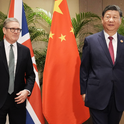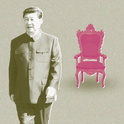In mid-January, delegates gathered in Ürümqi, the capital of China’s Xinjiang Uighur Autonomous Region, for the annual meeting of the regional People’s Congress. They listened attentively to the chairman, Shohrat Zakir, as he gave a report on behalf of an administration accused by the UN of incarcerating up to one million Uighurs in extra-judicial internment camps.
There was one upbeat piece of news: tourism in Xinjiang is booming, up 40 per cent on the previous year. In other respects, the chairman’s report was more sombre: the government, he said, will maintain “high pressure on curbing terrorist activities.”
The intensity of this pressure has been documented through eye-witness testimony, digital mapping, and analysis of government contracts for the building of the (now extensive) network of detention camps in which people are held indefinitely, without being charged or convicted of any crime. Beijing at first denied their existence, then justified them as counter-terrorism measures. But there are many unanswered questions, beginning with the nature of the problem that they claim to address.
There has been unrest in Xinjiang ever since the territory and its Muslim, Turkic peoples were incorporated into the Qing empire in the 18th century. More recently, nearly 200 people died in violent riots in 2009, triggered by social media footage of an assault on Uighur workers in a toy factory in distant Guangdong province. After a rumour that a Uighur worker had assaulted a Han Chinese woman, Han men attacked their Uighur co-workers in the factory dormitory. Street protests in Ürümqi became riots as Uighurs turned on Han Chinese migrants.
There had been bus bombings in 1992 and 1997, and between 2010 and 2014 a number of violent incidents that were either claimed by or attributed to the shadowy East Turkestan Islamic Movement. But serious though these episodes were, they do not reach the scale of the threat claimed by Zakir in an interview published last October.
“Chen developed the repressive techniques in his role as Party Secretary of Tibet—and takes full advantage of digital technology”“Since the 1990s, terrorists, extremists and separatists in China and abroad,” he said, “have plotted, organised and conducted thousands of violent terrorist attacks, including bombings, assassinations, poisoning, arson, assaults, unrest and riots, causing the deaths of a large number of innocent people and hundreds of police officers.” If that is true, these episodes have passed unreported in China, let alone in the rest of the world.
There is no doubt, however, about the escalating scale of repression. Since 2009 the state has recruited 90,000 extra police officers in Xinjiang, voted a 356 per cent increase in the security budget and initiated the mass incarceration of Uighur citizens for refusing to drink alcohol or eat pork, having beards or wearing veils, observing Ramadan, having relatives abroad or having been abroad themselves. Civil unrest triggered by state actions such as the destruction of mosques has been conflated with pre-planned acts of terror, and Beijing has rolled out a region-wide programme of collective punishment.
Why, and why now, is less clear. Xinjiang has always been a frontier. Since the collapse of the Soviet Union, it borders eight countries: Mongolia, Russia, Kazakhstan, Kyrgyzstan, Tajikistan, Afghanistan, Pakistan and India. Colonised from the 1950s in a military-led programme, it is an important source of oil. It has rarely seemed content under Chinese rule and the 20th century saw efforts to establish an independent republic. After the emergence of radical Islam in Afghanistan, and the independence of the states of former Soviet Central Asia, those dreams seemed likely to be revived. It was a prospect that made the Chinese government sensitive to the region’s cultural and religious identities. Today, those sensitivities are heightened by Xi Jinping’s Belt and Road ambitions: to build infrastructure across Eurasia, he must pass through Xinjiang.
The Party Secretary of Xinjiang, Chen Quanguo, developed many of the repressive techniques he is applying now in his previous role as Party Secretary of Tibet. Chen is also taking full advantage of digital technologies. Techniques include grid-style management using CCTV and data analytics to monitor all activities; the installation of surveillance apps on mobile phones; the registration of ID numbers on any knife purchased; DNA registration; the control of travel tickets and of the purchase of petrol; and latterly the compulsory billeting on Uighur families of Han Chinese “volunteers,” who lecture their involuntary hosts on correct political attitudes and report any transgression, such as religious observation.
Most notoriously, Chen has overseen the construction of the huge network of internment camps, described in euphemistic terms as re-education centres, in which internees are taught the dangers of extremist thinking and learn to love the party. How internees win their freedom seems as arbitrary as the initial detention, but few appear to have been released.
As to the future, in his surreal work report to the delegates, Zakir promised that tourism will become a pillar industry and Xinjiang a popular destination worldwide. On the deep legacy of resentment and alienation that the party state is building, he was silent.













